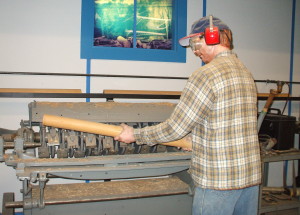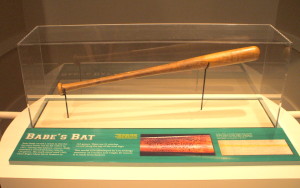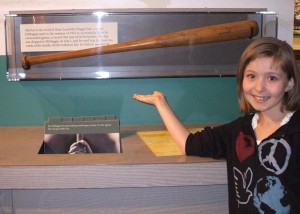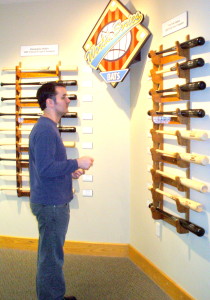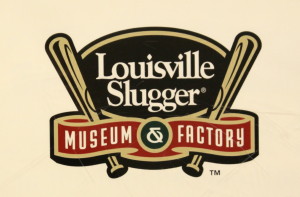 In celebration of baseball season starting at the end of March, I thought it would be a great time to let you know about a trip we took to the Louisville Slugger Museum in 2010. There were four of us on this trip and we were excited to see the baseball bat factory tour and the baseball memorabilia exhibits, especially my husband and son.
In celebration of baseball season starting at the end of March, I thought it would be a great time to let you know about a trip we took to the Louisville Slugger Museum in 2010. There were four of us on this trip and we were excited to see the baseball bat factory tour and the baseball memorabilia exhibits, especially my husband and son.
The Louisville Slugger Museum and Factory is located in Louisville, Kentucky and is one of the city’s most popular attractions. Outside, in front the building, visitors are greeted by a huge baseball bat to announce that it is the Louisville Slugger Factory where Hillerich & Bradsby Co. manufacture their brand of baseball bats. The building also serves as the Louisville Slugger Museum and corporate headquarters.
In the front lobby is a Signature Wall where there are thousands of famous baseball players’ signatures that were “burned” onto their Louisville Slugger bats. There is also a special section honoring the players and managers that have contracted with Louisville Slugger and been elected to the National Baseball Hall of Fame in Cooperstown, NY. After purchasing our admission tickets at the box office, we received a timed factory tour ticket. We had some time before our tour started, so we went to an area in the museum called Bud’s Batting Cage. The batting cage is named in honor of Bud Hillerich, who in 1884 made the first Louisville Slugger bat. Visitors to the batting cage can use replica bats of baseball legends, such as: Babe Ruth and Ted Williams.
Finally, it was time for our Louisville Slugger Factory tour. The guided tour lasts approximately 30 minutes. To start the tour, our guide gave a brief history of the Louisville Slugger company and the baseball bat production process. Then we had the opportunity to see the bats being made in the factory. We stopped at the different stations on the production line and the guide explained each process. At the end of the tour, everyone receives a miniature Louisville Slugger souvenir bat.
When we exited the tour, there is an area where we walked among life-size mannequins of baseball legends like Babe Ruth, Ted Williams, Joe Di Maggio, Ken Griffey Jr. and Derek Jeter. Also in this area is the Grand Slam Gallery, where there are displays of the bats of some of the past and present greatest hitters of the game of baseball, including Mickey Mantle, Johnny Bench and Joe Di Maggio. One interesting bat was Babe Ruth’s bat where he carved the notches for the 60 home runs that he hit within his record setting season in 1927. We took our time walking through the other exhibits of a variety of very interesting baseball memorabilia.
Of course, after a tour and museum visit, there is always a trip to the gift shop. In the Louisville Slugger Museum store there is an assortment of items, such as clothing and sports apparel, jewelry, key chains, home accessories and other collectibles. This is also the place to order and pick up personalized baseball bats. HINT: If you are planning on purchasing one of these personalized bats, place the order before taking the tour and visiting the museum. That way the order can be processed, the item can be made and it will be available for pick-up before you leave the Louisville Slugger facility.
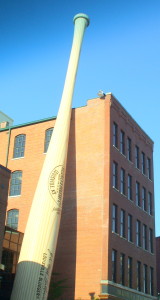
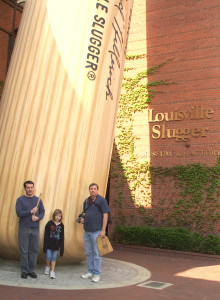
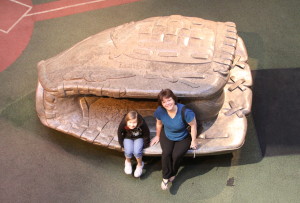 Information on the Louisville Slugger Factory and Museum
Information on the Louisville Slugger Factory and Museum
- If you are waiting for a scheduled tour to start and have some time, go to the theater to see the 13 minute film, “The Heart of the Game”. This inspiring film enjoyable insights and stories of hitting a baseball from some of the past and present top baseball players.
- The Big Bat is located outside in the front and was positioned there, leaning against the building in 1995. It is 120 feet tall, 68,000 pound exact replica of Babe Ruth’s Louisville Slugger, with the signature of Bud Hillerich who made the first Louisville Slugger bat in 1884. The bat is made of carbon steel and hand painted to simulate wood. It is hallow inside and if filled with water it would hold 30,000 gallons.
- The Gove Sculpture is located near the parking lot elevator. It is made from a piece of Kentucky limestone which is sculpted into a 34,000 pound replica of a baseball glove with a baseball inside. It is 12 feet long by 9 feet wide and four feet high. When it was delivered in 1998, the front doors of the building had to be removed to allow the massive sculpture to be positioned inside the building.
- The Louisville Slugger Walk of Fame is located just outside the door on historic Main Street and continues for one mile to the Louisville Slugger Field located on East Main Street. The bronze cast sculptures of a home plate are of baseball players selected by the Louisville Slugger management team. The name and information of the inductee is engraved on a home plate with a bronze baseball bat leaning nearby.
A Breif History of the Louisville Slugger Baseball Bat
J. Frederick Hillerich emigrated from Germany first to Baltimore, Maryland in 1842 and then a move to Louisville, Kentucky in 1856. In Louisville, he started a woodwork shop and produced everything from balusters to bedposts. His eldest son, John Andrew “Bud” was born in 1866 who later became an amateur baseball player with a local team.
Bud began making baseball bats for himself and his team. The legend is told that he made the first professional baseball player bat for Pete Browning in 1884. Browning was a star player for the Louisville professional American Association team. After Bud witnessed Browning breaking his favorite bat, Bud made an offer to make one for his hero. After Bud made the bat, Browning used it to make three hits in the next game. An interesting note: Browning was as a powerful hitter with the nickname of Louisville Slugger. Years later, as the Hillerich family began to successfully make a business of producing quality bats; they trademarked the name for their bats in 1894.
Initially, Bud’s father wanted nothing to do with making bats. But Bud continued producing his bats for a growing number of players and he continued to make improvements on the manufacturing process. Finally, when the bat production showed profits and increasing orders, Bud’s father made him a partner in 1897. The name was changed to J.F. Hillerich and Son.
In 1905 Honus Wagner, nicknamed “The Flying Dutchman”, was a shortstop for the Pittsburgh Pirates. He became the first big league baseball player to sign a contract to endorse the Louisville Slugger bats. His autograph burned into the bat was to become a long tradition with the company. The success of the Louisville Slugger bat was due to the fact that amateur baseball players were able to purchase a bat made exactly like their favorite big league player.
In 1911, Frank Bradsby, a successful salesman for the Louisville Slugger bats joined the company as a full partner and the company was renamed the Hillerich & Bradsby Co. and is the name that is still used today. J. Frederick Hillerich died in 1924. Then, in 1937 a disastrous flood of the Ohio River significantly damaged one of the factories and some of the offices. This event and the massive efforts to rebuild is said to have hastened the death of Bradsby later the same year. Bud Hillerich died in 1946 and his son Ward took over as president of the company, but his term was short and he died in 1949. Bud’s second son John Hillerich Jr then took over as president until his death in 1969. His son, John Hillerich III became president of the company at the age of 29 years old.

